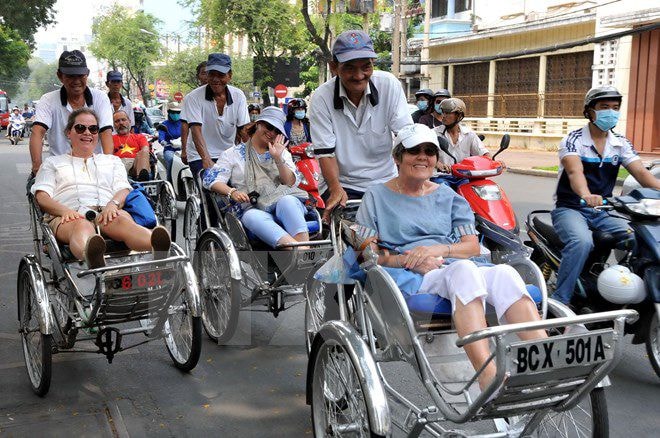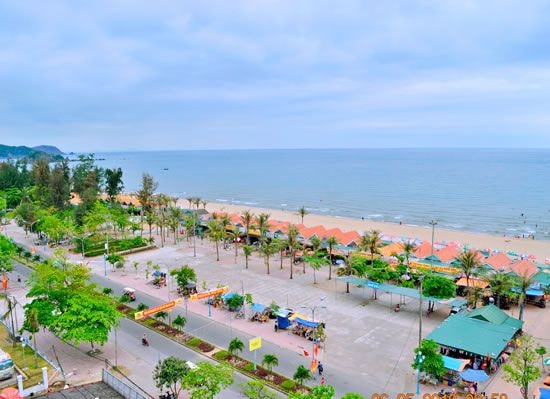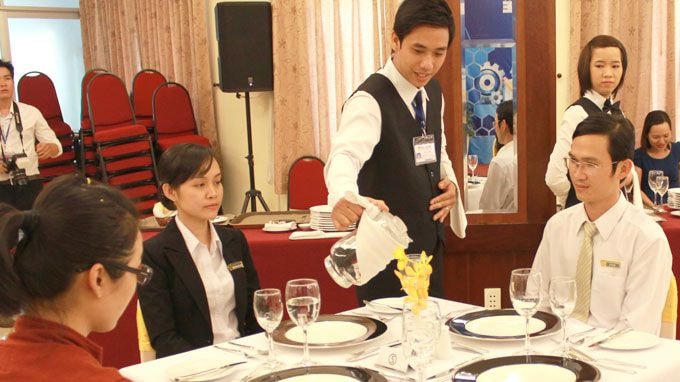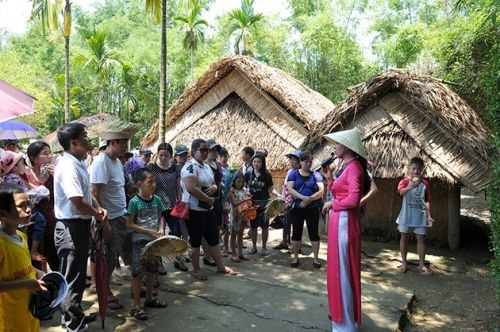Tourism pioneers in ASEAN community integration
At the end of 2015, the ASEAN Community will be officially formed with three main pillars: Political-Security Community; Economic Community; and Socio-Cultural Community. The birth of the ASEAN Community will impact all economic, political, cultural and social fields, including tourism.
 |
| Tourists tour Ho Chi Minh City by cyclo. (Photo: An Hieu/VNA) |
Opportunities intertwine with challenges
Director General of the General Department of Tourism (Ministry of Culture, Sports and Tourism) Nguyen Van Tuan said: The formation of the ASEAN Community is a major event, affecting all fields, in which tourism is the first field to be affected and the industry has also been a pioneer in integration compared to other fields.
Mr. Nguyen Van Tuan stated: ASEAN countries themselves are large markets, when joining this community, we can exploit a huge number of potential visitors, especially international visitors and attract investment in tourism. The ASEAN community creates opportunities for countries in the region to exchange and rotate labor. We have the opportunity to send Vietnamese workers to work in countries in the region, but we may also lose some jobs, especially senior management positions. Vietnamese workers are dynamic, creative, intelligent, but still have limitations in qualifications, soft skills, foreign languages, especially labor discipline. Therefore, if we do not quickly improve our capacity, the tourism industry is also at risk of losing right at home.
In addition, the ASEAN integration process requires countries to increase their competitiveness, but also creates opportunities for bilateral and multilateral cooperation to create a common ASEAN destination that is increasingly attractive to international tourists. This cooperation aims to implement messages such as: 5 countries 1 destination, or 3 countries 1 destination between Vietnam, Laos, Cambodia, Myanmar, Thailand. This trend of integration is becoming increasingly strong and Vietnam tourism must take advantage of this opportunity. It must also be affirmed that, among the 5 countries in the Mekong sub-region mentioned above, there is close cooperation not only in forums, but also through practical activities, especially in the field of cooperation in promoting and advertising tourism, attracting visitors from distant markets to the ASEAN region.
 |
| Cua Lo Beach - one of the most attractive destinations in Vietnam (illustrative photo) |
Regarding the tourism industry, Mr. Nguyen Van Tuan affirmed that he has proactively and actively prepared all the conditions to integrate into the ASEAN Community on tourism, through the MRA-TP mutual recognition agreement in tourism professions. Over the past years, the tourism industry has focused on preparing the necessary contents, in which the most important step is to raise awareness and propaganda so that the business community and workers understand the requirements, opportunities and challenges of integration; complete 8 sets of occupational standards supported by the EU-ESRT Project (VTOS) to be recognized in ASEAN; form a vocational institution in the tourism industry, in which it is important to establish the National Tourism Profession Council, the National Tourism Profession Certification Council, etc.
Urgently complete tourism professional standards
In 2015, the ASEAN Community will officially be established, and countries in the community will recognize each other's qualifications of workers, including those in the tourism sector. Therefore, it is necessary to set common standards for countries to apply. To facilitate the movement of skilled workers in the region, thereby promoting investment and trade, ASEAN countries have signed 8 Mutual Recognition Agreements (MRAs), allowing certificates of skilled workers in one country to be recognized by other member countries in the region; in the tourism sector, it is the Mutual Recognition Agreement on Tourism Workers (MRA-TP).
 |
| Improving vocational skills helps tourism workers gain a more stable foothold (illustrative photo) |
In the region, the ASEAN Common Tourism Occupational Standards and Training Curriculum for the six tourism occupations that attract the most workers have been completed: reception, housekeeping, restaurant service, food preparation, tourism operations, and travel agencies. Currently, ASEAN is urgently completing the factors to ensure that the MRA-TP takes effect and is officially applied in early 2016; establishing the ASEAN Tourism Professional Monitoring Committee (ATPMC) to implement the MRA-TP.
Participating in the process of finalizing common standards, Vietnam has fully implemented the responsibilities of a member country. The tourism industry has also selected and nominated suitable personnel to participate in training programs organized by ASEAN to develop a team of ASEAN Trainers and ASEAN Assessors for the following occupations: Housekeeping, food preparation, reception and restaurant service. Vietnam has also participated in developing and disseminating training and assessment guidelines for tourism workers according to occupational standards; common tourism training curriculum in ASEAN.
Vietnam's tourism industry is completing the construction and development of a national tourism occupational standards system (8 sets of national occupational standards have been issued and 10 sets of tourism occupational standards under the VTOS system supported by the European Union are in the process of converting into national tourism occupational standards) to have enough sets of standards to compare and recognize as equivalent to common occupational standards in ASEAN...
The implementation of these General Agreements brings many benefits. Enterprises and workers will have the conditions to develop their capacity and have their professional qualifications recognized. For enterprises, they will have a set of standards to apply for on-site training, workers who meet the vocational skills in the ASEAN common standards will better meet the needs of international and domestic tourists. Enterprises will have more recruitment opportunities in ASEAN. The competitiveness of tourism enterprises will increase and the quality of services of enterprises will also be improved. Vietnamese workers with high skills, qualifications, and proficiency in foreign languages have the opportunity to find jobs and high incomes in Southeast Asian countries...
 |
| Tour guide at Kim Lien relic site (Nam Dan - Nghe An) (illustrative photo) |
However, when implementing MRA-TP, there will also be many highly skilled workers in the ASEAN bloc coming to work in Vietnam. Mr. Tran Phu Cuong, Deputy Director of the Department of International Cooperation, General Department of Tourism, explained: It is not true that foreign tourism workers will flood into Vietnam at the beginning of 2016, but the tourism industry must proactively prepare to welcome this wave. In fact, tourism is a pioneer industry preparing for ASEAN integration with the formation of the National Tourism Council, the National Tourism Certification Council, and the application of the VTOS tourism skills standards. Tourism vocational training schools under the Ministry of Culture, Sports and Tourism have also applied the VTOS standards, facilitating mutual recognition of professions in ASEAN.
According to the General Department of Tourism, ASEAN countries have agreed not to include the tour guide profession in the MRA-TP list because compared to 6 professions such as reception, housekeeping, restaurant service, food preparation, tourism operation, travel agency, tour guide has its own characteristics. Tour guides in each country must be natives to have a good understanding of the culture and history of their country and be cultural ambassadors expressing the unique identity of each country...
Deputy General Director Ha Van Sieu also emphasized: MRA-TP opens up many opportunities but also puts Vietnam's tourism industry in front of many new challenges. To take advantage of the benefits from MRA-TP and the tourism integration process in ASEAN, careful and proactive preparation is required from state management agencies on tourism at all levels, businesses, tourism training facilities and workers. This needs to be done through activities to strengthen human resource development management, organize training, self-training, strengthen internal strength, and increase the competitiveness of businesses and tourism training facilities. At the same time, Vietnam also needs to have policies to attract and retain talent in an increasingly competitive environment of the ASEAN region./.
According to VNA
| RELATED NEWS |
|---|
